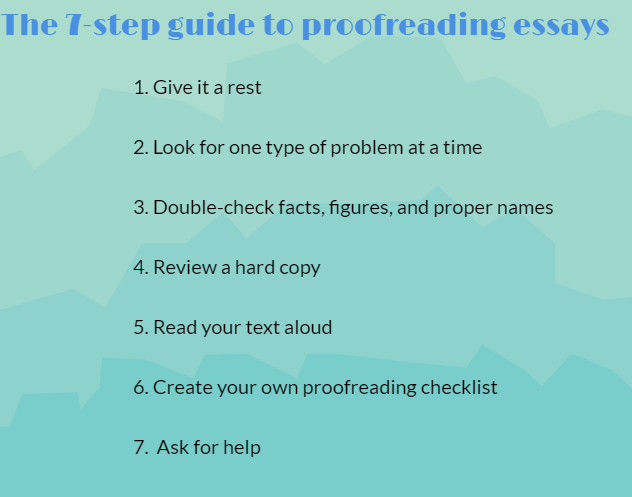
Writing an academic paper in English is no small feat. Whether you are writing for a class, submitting to a journal, or preparing for a conference, the quality of your paper plays a significant role in determining your grade or acceptance. One of the most important stages in academic writing is editing and proofreading. A welledited paper can elevate your argument, improve readability, and ensure that your research is presented in the best possible light.
In this article, we will explore seven crucial steps for effectively editing your English paper. Mastering these steps will help you quickly enhance your paper’s quality and significantly improve your chances of achieving higher grades or getting published.
1. Read Through Your Paper for Overall Structure
Before diving into specific language issues, the first thing you should do is step back and assess the overall structure of your paper. A wellorganized paper makes a strong argument, is easy to follow, and ensures that your readers can navigate through your ideas without confusion.
Introduction: Does your introduction clearly present the topic, explain its significance, and outline the main argument or thesis?
Body: Are your ideas presented logically, with clear topic sentences and sufficient evidence to support each claim? Ensure that each paragraph transitions smoothly to the next.
Conclusion: Does your conclusion summarize the main points and tie them back to the thesis, leaving the reader with a clear understanding of the paper’s contributions?
If the structure of your paper feels disjointed or lacks clarity, it is crucial to revise it before moving forward with more detailed edits.
2. Check for Clarity and Coherence
Clarity and coherence are key to a wellwritten academic paper. The purpose of editing is not just to fix grammatical errors, but to ensure that your ideas are presented in a clear and logical manner. Ask yourself the following questions:
Does the paper flow smoothly? If you were a reader unfamiliar with the topic, would you be able to follow the argument easily?
Are your ideas clearly articulated? Avoid overly complex or convoluted sentences. If a sentence feels hard to read, break it into smaller, simpler components.
Do you provide enough context for each claim? Sometimes, writers assume that their readers are familiar with certain background information. Ensure that all key concepts are explained, and your sources are properly integrated into the paper.
It is often helpful to read the paper aloud to identify awkward phrasing or unclear ideas. If a sentence or paragraph feels jumbled or difficult to follow, take the time to rewrite it for better clarity.
3. Focus on Grammar and Syntax
Correct grammar is essential for academic writing. Even if your ideas are strong, poor grammar can significantly undermine the quality of your paper. Start by checking for basic grammar issues:
SubjectVerb Agreement: Ensure that your subject and verb match in number (singular or plural). For example, "The students are working" vs. "The student are working" (incorrect).
Tense Consistency: Be mindful of maintaining consistent verb tenses throughout the paper. A common mistake is switching between past and present tense unnecessarily.
Punctuation: Proper punctuation ensures that your ideas are conveyed correctly. Misplaced commas, periods, and semicolons can alter the meaning of a sentence.
After focusing on these basic issues, review sentence structure. Ensure that sentences are complete and avoid runon sentences or sentence fragments. If necessary, break long sentences into shorter ones for readability.
4. Eliminate Redundancy and Wordiness
Academic writing should be concise and to the point. Avoid unnecessary repetition and wordiness, which can distract the reader and weaken your argument. Here are a few tips:
Remove redundant words: Phrases like "each and every," "completely eliminate," or "final conclusion" can often be shortened without losing meaning. For instance, use "eliminate" instead of "completely eliminate."
Use precise language: Opt for more specific, concrete words instead of vague or general terms. For example, instead of saying "many different types of," say "several types of."
Eliminate filler words: Words like "very," "really," "quite," or "just" often don’t add value to your writing and can usually be cut out.
By trimming down unnecessary words, you make your paper more focused and efficient, improving both readability and clarity.

5. Ensure Consistency in Formatting and Style
Formatting plays a vital role in academic papers. Consistency in style ensures that your paper looks professional and follows the requirements of the target publication or institution. Check the following:
Citation Style: Ensure that you have correctly followed the citation style required for your paper (APA, MLA, Chicago, etc.). This includes both intext citations and your reference list.
Headings and Subheadings: Use consistent formatting for headings and subheadings to organize your paper. This helps guide the reader and makes it easier to locate specific sections.
Font and Spacing: Doublecheck that your font, size, and spacing align with the guidelines you are following (e.g., Times New Roman, 12point font, doublespaced).
Small formatting errors can detract from the professionalism of your paper, so ensure that you follow the guidelines precisely.
6. Check Your Sources and Citations
The credibility of your paper relies heavily on how well you incorporate and cite your sources. Accurate citation not only shows respect for intellectual property but also strengthens your argument by demonstrating your research process. During the editing phase:
Crosscheck all citations: Make sure that every source you reference in the text appears in your reference list, and that all citations are formatted correctly.
Verify direct quotes: If you have included direct quotes, doublecheck that they are accurate and properly attributed to the original author.
Ensure proper paraphrasing: Ensure that you have paraphrased ideas from sources correctly and have not plagiarized. Paraphrasing involves rewriting someone else’s ideas in your own words and citing them properly.
Mistakes in citations or the improper use of sources can seriously affect your paper’s credibility. So, take the time to ensure accuracy.
7. Final Proofread and Polish
After going through the previous steps, it’s time for a final proofread. This step involves carefully reviewing your paper for any minor issues that may have been missed earlier. Focus on:
Spelling and typos: Even the most thorough edits can sometimes miss small spelling mistakes. Use spelling and grammar checkers, but also read the paper carefully to catch any errors.
Sentencelevel improvements: Revisit each sentence for flow and readability. Ensure that each sentence contributes meaningfully to your argument.
Final consistency check: Review the paper one more time for consistency in style, tone, and formatting.
A final proofread will help catch any lingering errors and ensure that your paper is polished and professional.
Effective editing is an essential skill for academic writing. By following these seven steps—reviewing your paper’s structure, focusing on clarity, checking grammar, eliminating redundancy, ensuring consistency, verifying citations, and proofreading—you can significantly improve the quality of your paper. With practice, you’ll develop an eye for detail and an ability to polish your work to perfection. This will not only help you achieve better grades but also enhance your credibility as a writer. So, the next time you sit down to edit your paper, remember these essential steps for a more polished and professional result!
使用E-convier论文代写服务,让您的论文轻易取得A+!
来自课程大数据表明, 使用E-convier的论文代写之后,留学生作业优秀率由基准值28%提升至42%,
由母语导师团队提供针对性写作支持,确保论文符合院校评分标准与学术规范。











